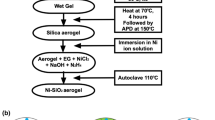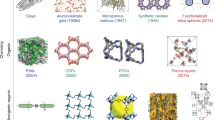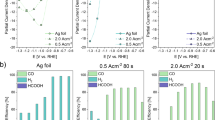Abstract
Porous inorganic solids can be synthesized in complex forms1,2, and here we describe a simple method to create an ultralight, macroporous, crystalline vanadium oxide foam by bubbling oxygen gas produced in situ through a viscous vanadium oxide gel. This foaming process could be extended to other metal oxides.
Similar content being viewed by others
Main
Vanadium oxide (V2O5) powder (1 g, or 5.5 × 10−3 mol) is mixed with a solution of a long-chain alkylamine (1-hexadecylamine, C16H33NH2; 1.99 g, or 8.24 × 10–3 mol) in acetone (3 ml). A pasty material is formed, to which is added an aqueous solution of hydrogen peroxide (50 ml, 30%). As H2O2 decomposes, oxygen gas evolves and a voluminous bright yellow foam forms spontaneously (Fig. 1). The volume of the foam increases rapidly and reaches 2.5 litres after about 30 min. This new material is ultralight, as only 1 g V2O5 is needed to generate the large volume of foam.
Scanning electron microscopy of the foam (Fig. 2a) reveals that it is highly porous and has an irregular, honeycomb-like morphology. Large pores a few micrometres in diameter are surrounded by vanadium oxide walls about 1 µm thick. This unusual pattern resembles the hexagonal cellular structures found in the skeletons of some diatoms and radiolarians3. The mechanical properties of this porous material are poor — the ultralight foam is brittle and can easily be crushed into a powder.
The vanadium oxide walls are crystalline, and X-ray diffraction reveals five sharp peaks that can be assigned to the 00l peaks of a lamellar solid with a preferred orientation (Fig. 2b). The first 001 peak gives a basal distance, d, of 33.4 Å, which is much larger than the distance between vanadium oxide planes in the crystalline oxide or in V2O5,1.6H2O gels (d = 11.5 Å). This basal distance corresponds to that noted for hexadecylamine molecules intercalated in vanadium oxide gels in which the alkyl chains are perpendicular to the oxide planes4.
Contrary to observations of hybrid organic–inorganic vanadium oxide com pounds, the bright yellow coloration of our vanadium oxide foam indicates that all the vanadium ions are probably in their highest oxidation state (V5+). The hybrid foams contain no water, even when dried at room temperature, and they have amphiphilic alkylamines intercalated between vanadium oxide layers and are highly hydrophobic, separating readily at the surface of an aqueous solution.
Vanadium oxide reacts with hydrogen peroxide to give V2O5.nH2O gels5 that have a layered structure composed of negatively charged vanadium oxide ribbons. These gels can intercalate a wide variety of inorganic and organic species, such as protonated long-chain alkylamines6. In the foaming process described here, gelation and intercalation both occur when the 1-hexadecylamine and hydrogen peroxide solutions are added to vanadium oxide powder. The intercalation of hexadecylamine between the V2O5 layers creates a pasty solid, while the hydrogen peroxide decomposes spontaneously in the presence of vanadium oxide. Large pores are formed by oxygen gas released through the viscous gel in the presence of surfactants: as they escape, the oxygen bubbles cause the formation of a voluminous polygonal foam, without destroying the crystalline structure of the oxide network of surfactant molecules intercalated between the layers of vanadium oxide.
Meso- and macroporous solids are usually made in the presence of organic templates which then have to be removed without damaging the inorganic shell7,8. In the foaming method we describe here, amines are simply intercalated between vanadium oxide planes and do not act as templates for the formation of macropores. The experimental requirements are not crucial — foams can form with amine/V2O5 molar ratios ranging from 0.5 to 2.5, other surfactants can be used and the process can be extended to many different oxides (for example, those of molybdenum (MoO3), titanium (TiO2) and zirconium (ZrO2)).
References
Mann, S. Angew. Chem. Int. Edn 39, 3392–3406 (2000).
Mann, S. & Ozin, G. A. Nature 382, 313–318 (1996).
Williams, R. J. P. in Biomineralization (eds Mann, S., Webb, J. & Williams, R. J. P.) 1–34 (VCH, New York, 1989).
Livage, J. Chem. Mater. 3, 578–593 (1991).
Alonso, B. & Livage, J. J. Solid State Chem. 148, 16–19 (1999).
Liu, P., Moudrakovski, I. L., Liu, J. & Sayari, A. Chem. Mater. 9, 2513–2520 (1997).
Kresge, C. T., Leonowicz, M. E., Roth, W. J., Vartuli, J. C. & Beck, J. S. Nature 359, 710–712 (1992).
Yang, P., Zhao, D., Margolese, D. I., Chmelka, B. F. & Stucky, G. D. Nature 396, 152–155 (1998).
Author information
Authors and Affiliations
Corresponding author
Ethics declarations
Competing interests
The authors declare no competing financial interests.
Rights and permissions
About this article
Cite this article
Chandrappa, G., Steunou, N. & Livage, J. Macroporous crystalline vanadium oxide foam. Nature 416, 702 (2002). https://doi.org/10.1038/416702a
Issue Date:
DOI: https://doi.org/10.1038/416702a
This article is cited by
-
Effect of porosity distribution on flexural and free vibrational behaviors of laminated composite shell using a novel sinusoidal HSDT
Archives of Civil and Mechanical Engineering (2024)
-
Optimized processing of defect-free porous alumina by gel casting process
Journal of Porous Materials (2019)
-
Selective synthesis of scheelite/perovskite CdWO4 nanoparticles: a mechanistic investigation of phase formation and property correlation
Journal of Sol-Gel Science and Technology (2018)
-
In situ inward epitaxial growth of bulk macroporous single crystals
Nature Communications (2017)
-
Insertion study of alkali metal cations into layered vanadium oxide foam
Journal of Sol-Gel Science and Technology (2015)
Comments
By submitting a comment you agree to abide by our Terms and Community Guidelines. If you find something abusive or that does not comply with our terms or guidelines please flag it as inappropriate.





